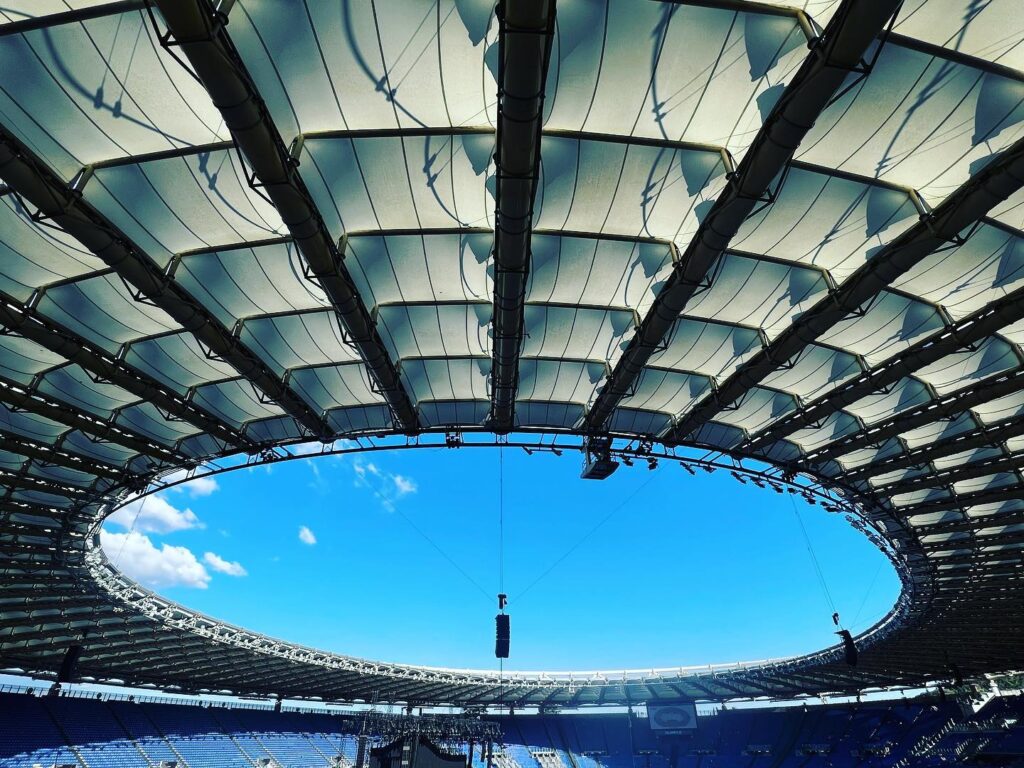
Step into the enchanting realm of Stadio Olimpico, a majestic sporting sanctuary where history, passion, and indelible memories converge.
The Birth of Stadio Olimpico: An Iconic Sporting Arena is Born
Conceived as a centerpiece for the 1942 “Mondo di Roma” World Fair, the monumental project was brought to life by architect Enrico Del Debbio.
Alas, the World Fair was not to be. The eruption of World War II dealt a devastating blow, forcing the cancellation of the Stadio Olimpico project. The stadium, like Rome itself, was destined to become a symbol of resilience and rebirth.
Following the war, construction resumed on the massive arena, which was completed in 1953. The stadium boasted an initial capacity of 100,000 spectators—a real-life coliseum for the modern era!
Unforgettable Moments: The Most Iconic Matches in Stadio Olimpico’s History
Stadio Olimpico has witnessed numerous unforgettable moments in the world of sports, establishing itself as a legendary sporting arena.
The 1990 FIFA World Cup Final
The unforgettable match between West Germany and Argentina was watched by millions around the world. With a single goal by Andreas Brehme, West Germany clinched the World Cup title.
The 2009 UEFA Champions League Final
It was Manchester United vs. Barcelona, a match that, for many, symbolizes the peak of soccer brilliance. Barcelona’s 2-0 victory was highlighted by Lionel Messi’s header, a moment still remembered in soccer history.
Rugby Six Nations Championship
Stadio Olimpico is also home to thrilling rugby matches. The stadium hosts the Italian team’s matches in the Six Nations Championship. In 2013, Italy’s stunning victory over France sparked an explosion of joy, marking one of the stadium’s most memorable rugby moments.
The Rivalries of Stadio Olimpico: The Most Memorable Derby Matches
Stadio Olimpico has witness countless epic battles between fierce rivals.The energy, the tension, the drama – it’s all part of the Olimpico derby experience.
One rivalry that stands out is the infamous ‘Derby della Capitale’ between A.S. Roma and S.S. Lazio. This legendary feud, seething with decades of intense competition and passionate fan bases, happens right here, on the hallowed pitch of Stadio Olimpico.
The Derby of 26 May 2013
For a match that truly epitomizes the essence of this rivalry, we turn back the clock to 26 May 2013. The Coppa Italia final – A.S. Roma vs S.S. Lazio – was an occasion that brought the city of Rome to a standstill.
The match ended 1-0 in favor of Lazio, with Senad Lulic scoring the lone goal. It was a day of ecstasy for Lazio fans, and one of despair for the Roma faithful.
The Derby of 4 December 2016
The derby of 4 December 2016 is another match etched in the annals of Stadio Olimpico’s history. A.S. Roma’s 2-0 win over Lazio was a game of sublime skill and tactical masterclass, with Roma’s iconic number 10, Francesco Totti, stealing the show.
Totti’s delightful chip over Lazio’s goalkeeper from 25 yards out was a moment of pure brilliance that underscored his status as one of football’s greats.
The Legends of Stadio Olimpico: The Most Iconic Players to Grace the Arena
When you speak of Stadio Olimpico, a few legendary names come to mind.
Francesco Totti: The King of Rome also known as “Il Gladiatore” for his commendable performances for A.S Roma, Totti’s name became synonymous with the stadium itself. His astounding goal against Lazio in the Rome derby of 1998 is still fresh in the memories of football aficionados.
Diego Maradona: Closely associated with Napoli, Maradona also had a significant history with Stadio Olimpico as well. His unforgettable performance in the 1990 World Cup semi-final, held at this very ground, is still hailed as one of his best games. Maradona’s flair and agility on the field left spectators spellbound, making him a legend of the game.
Paolo Rossi: AC Milan’s stalwart defender, weaved his magic at the Stadio Olimpico numerous times. His remarkable hat-trick against Brazil in 1982 World Cup is often remembered , making him a beloved figure at the Stadio Olimpico. His exceptional skills and strategic play solidified Paolo Rossi’s place in football folklore. His spirit continues to resonate within the walls of the stadium.
Roberto Baggio: Roberto Baggio, an Italian soccer icon, had his fair share of defining moments at Stadio Olimpico. His exceptional skills and trademark penalty shots made him a crowd favorite, and his heroics during the 1990 World Cup remain a beloved memory for fans. .
A Fan’s Guide to Stadio Olimpico: Tips and Tricks for Your Next Visit
A visit to Rome’s Stadio Olimpico is an experience you won’t ever forget. To make the most out of your visit, it helps to know a few insider tips and tricks.
Getting There
Stadio Olimpico, located in the Foro Italico sports complex, is well connected by public transport. Bus lines 32, 280, and 910 will drop you right outside the stadium. If you’re up for a scenic route, catch Tram 2 from Piazzale Flaminio, near the city center.
Grabbing a Bite
Nothing completes a stadium visit like local food. Around the stadium, you’ll find numerous food trucks and stalls serving up traditional Roman street food. Don’t miss out on “supplì”, a deep-fried risotto ball, and “porchetta”, a savory, fatty, and moist boneless pork roast.
Joining the Sea of Fans
To truly feel the electrifying atmosphere, don’t shun the local fans – join them! It might get loud and passionate, but that’s the very essence of Italian “calcio” (soccer). Just remember, respect is paramount.
Stadium Tour
If you’re a history buff or a sports enthusiast, a stadium tour is a must. You’ll get to see the players’ dressing rooms, walk through the tunnel, and even step onto the pitch.
Souvenirs
Before you leave, make sure to pick up a souvenir. Whether it’s a team jersey, a scarf, or a simple keychain, it’ll serve as a tangible reminder of your unforgettable journey through Stadio Olimpico.
Remember, every visit to Stadio Olimpico is a chance to be part of history. So, embrace the experience, live the moments, and create memories that will last a lifetime.
The Best Seats In Stadio Olimpico Roma
There’s a certain thrill that comes with finding that perfect seat in a stadium, especially one as legendary as Stadio Olimpico. So, where are those prime spots in Rome’s iconic stadium? Let’s dive in.
For the Football Fanatics: Distinti Sud Est
For hardcore football enthusiasts, the Distinti Sud Est is the place to be. It offers a great view of the pitch and is close to the action. Just remember, this is where the most passionate fans gather, so be prepared for a high-energy experience.
For the Concert Goers: Primo Anello
When the Stadio Olimpico transforms into a concert venue, the Primo Anello becomes the most coveted area. It’s close to the stage with unobstructed views, making it an ideal spot for soaking in the music and atmosphere.
For the VIP Experience: Tribuna Tevere
Looking for a VIP experience? Look no further than the Tribuna Tevere. It’s a bit more expensive but offers cushioned seats, access to exclusive areas, and the best panoramic view of the stadium.
For the Budget Conscious: Curva Sud
If you’re on a budget but still want a decent view, the Curva Sud is a good choice. It’s one of the cheapest seating areas, yet it still offers a great view of the pitch, especially during football matches.
Remember, the best seat in Stadio Olimpico depends on what you’re there for and what kind of experience you’re after. So, choose wisely and enjoy the spectacle that this historic venue has to offer!
Rules and Regulations for Stadio Olimpico
Visiting the Stadio Olimpico can feel like stepping into a living history book of sports, but before you get swept away by the thrill of the game and the echoes of past glories, it’s crucial to familiarize yourself with the rules and regulations of this iconic sporting arena.
General Conduct
- Respect and courtesy are mandatory. Remember: we are all here to have good moments!
- Disruptive behavior won’t be tolerated. Keep the cheering sportsmanlike.
- No running in the concourses or stands – safety first!
Prohibited Items
- Weapons of any kind, flares, fireworks, and explosives are a strict no-no.
- Alcoholic beverages from outside are forbidden. But don’t worry, plenty of options are available inside!
- Large banners, poles, or any items that might obstruct the view are not allowed.
- Professional recording equipment, drones, and fireworks are prohibited.
Tickets and Seating
- Always have your ticket handy. Your seat number and entrance gate will be mentioned on it.
- Remember, seats can’t be changed once allocated.
- Children under the age of 5 may not require a ticket but must sit on an adult’s lap.
Remember, these rules are in place to ensure everyone has a great time while enjoying the spectacle of sport in this iconic arena. After all, the Stadio Olimpico is what it is because of you – the fans!
Where To Buy Tickets In Stadio Olimpico
So, you’ve decided to take in a match at the historic Stadio Olimpico, but you’re wondering where to secure your golden ticket to the action? Well, here are a number of options available.
Official Club Websites: The safest and most reliable way to buy tickets is directly from the official websites of A.S. Roma or S.S. Lazio, depending on which team is hosting the match. They provide an English version, ensuring a smooth transaction for international fans.
Sports Events 365: the official websites are sold out or you’re looking for specific seats, Sports Events 365 is a reliable alternative. It’s an international ticket vendor that sells tickets of various sports events around the world, including matches held at Stadio Olimpico.
Note: Always be mindful of unofficial ticket sellers. While you may stumble upon a seemingly good deal, it could end up in disappointment. Stick with recommended vendors to ensure a hassle-free experience.
At the Stadium
If you’re more of a last-minute planner or you enjoy the thrill of buying tickets at the venue, you can also purchase them at Stadio Olimpico itself. There are ticket booths, known as “biglietteria”, located around the stadium where tickets are typically available unless the match is a sell-out.
Note: At the stadium, payments are usually made in cash, so ensure you have enough Euros on hand. Also, remember that Italian games often sell out fast, particularly high-profile matches, so this option may not always be viable.
Exploring the Surroundings of Stadio Olimpico: A Guide to the Best Local Attractions
Just a stone’s throw from the Stadio Olimpico, Rome’s iconic sporting arena, lies a treasure trove of local attractions waiting to be discovered.From ancient Roman relics to lush green parks, the surroundings of Stadio Olimpico are worth exploring.
Here are some must-see spots:
The Olympic Village
La Villetta, as locals call it, was built for the 1960 Olympic Games. Today, it’s a vibrant residential area, dotted with cafes, parks, and art installations. Don’t forget to check out Piazza Mancini, a hub of activity and people-watching.
Ponte Milvio
North of the Stadio Olimpico, Ponte Milvio is an ancient Roman bridge and a popular spot for evening strolls. Its vibrant nightlife, food stalls, and the tradition of ‘love padlocks’ make it a hotspot for both locals and tourists.
MAXXI Museum
Art enthusiasts should not miss MAXXI, the National Museum of 21st Century Arts. Designed by Zaha Hadid, this architectural marvel houses some of the most thought-provoking contemporary art pieces in Italy.
Villa Borghese
A trip to the Stadio Olimpico isn’t complete without a visit to Villa Borghese. This verdant oasis offers a break from the city’s hustle and bustle with its manicured gardens, tranquil lake, and stunning sculptures.
Foro Italico
Right next to the Stadio Olimpico, Foro Italico is a sports complex known for its remarkable Fascist-era mosaics. It’s also home to the Rome Masters tennis tournament, an event that draws tennis enthusiasts from around the world.
